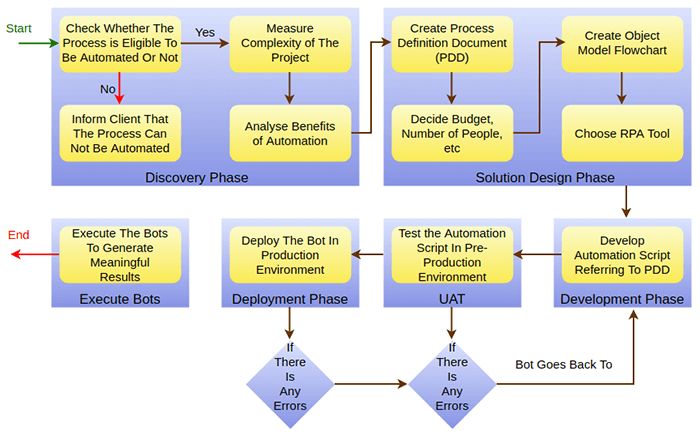RPA Life CycleRPA Lifecycle does not have any particular defined structure. It includes different phases of the automation process, from the creation of bots to the execution of the bots. Check out the following diagram displaying all these phases: 
Discovery PhaseThe discovery phase is the initial phase of the RPA lifecycle. In this phase, the RPA process architect analyzes the requirements of the client. Then it is further decided whether the process can be automated or not. If the process can be automated, then the RPA analyst team might involve the RPA architect team and analyze the complexity of the process. Solution Design PhaseBased on requirements, the steps to automate the task, are designed. The RPA technical architect, in collaboration with the process architect, develop a Process Definition Document (PDD), which includes information about the whole process. They follow the developmental methodology and develop a strategy to automate specific tasks to reduce manual work as much as they can. Once all the requirements are matched, the next step is to decide the budget, number of people, time to be spent on the project, etc. Then, the analyst team creates a flowchart to understand the flow of processes, which helps in choosing the right processes for automation. After the selection of processes, the RPA tool is used to start the development of bots and automate tasks. Development PhaseIn this phase, the RPA developer creates scripts/bots to automate the tasks with the help of RPA tools. There are several RPA tools available in the market. Automation scripts/bots are generated by following the previously developed PDD. Generally, there is no requirement for coding. But it may change depending on the tasks to be automated. After developing the bots, the next step is to test the developed bots. UAT (User Acceptance Tests)In this phase, the RPA development team tests the developed bots. These bots are tested in a pre-production environment to examine how the users can use them to automate specific tasks. If the testing phase gets passed successfully, then it is further transferred to the next stage. Besides, if the testing fails, then it is transferred back to the development phase, where RPA developers examine errors found in the testing phase and solve them. Once the bots get successfully tested, then they are transferred to the deployment phase of the RPA Lifecycle. Deployment and Maintenance PhaseThe bots are deployed into the production environment when only they have completed the development and testing phases. After the deployment process, users can use them to automate their tasks. If there is still a problem with the bots, like bots are not automating, then they are further transferred to the RPA development and testing team. The development team will again analyze the bots and resolve the problems. Execute BotsThis phase includes the execution of the bots after deployment. Bots are also checked to ensure that the implementation is performed as per requirements. The following image explains the flow of building a bot: 
Next TopicRPA Implementation
|
 For Videos Join Our Youtube Channel: Join Now
For Videos Join Our Youtube Channel: Join Now
Feedback
- Send your Feedback to [email protected]
Help Others, Please Share










